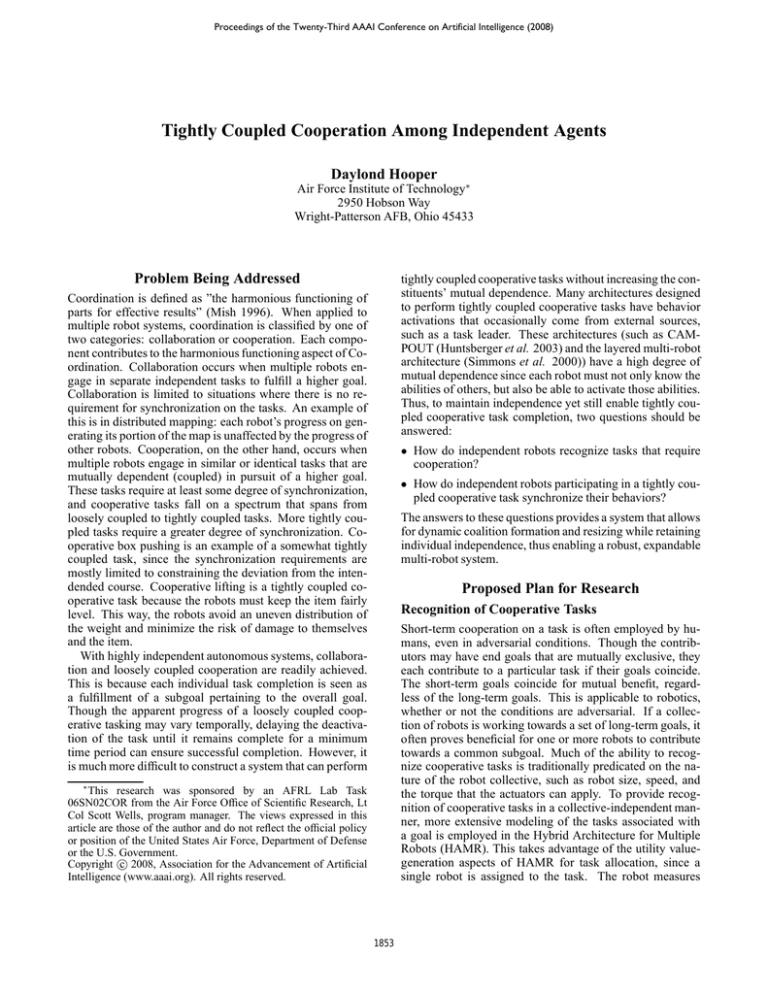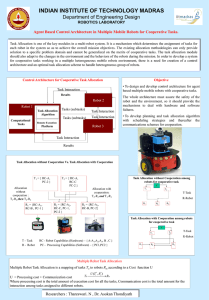
Proceedings of the Twenty-Third AAAI Conference on Artificial Intelligence (2008)
Tightly Coupled Cooperation Among Independent Agents
Daylond Hooper
Air Force Institute of Technology∗
2950 Hobson Way
Wright-Patterson AFB, Ohio 45433
Problem Being Addressed
tightly coupled cooperative tasks without increasing the constituents’ mutual dependence. Many architectures designed
to perform tightly coupled cooperative tasks have behavior
activations that occasionally come from external sources,
such as a task leader. These architectures (such as CAMPOUT (Huntsberger et al. 2003) and the layered multi-robot
architecture (Simmons et al. 2000)) have a high degree of
mutual dependence since each robot must not only know the
abilities of others, but also be able to activate those abilities.
Thus, to maintain independence yet still enable tightly coupled cooperative task completion, two questions should be
answered:
Coordination is defined as ”the harmonious functioning of
parts for effective results” (Mish 1996). When applied to
multiple robot systems, coordination is classified by one of
two categories: collaboration or cooperation. Each component contributes to the harmonious functioning aspect of Coordination. Collaboration occurs when multiple robots engage in separate independent tasks to fulfill a higher goal.
Collaboration is limited to situations where there is no requirement for synchronization on the tasks. An example of
this is in distributed mapping: each robot’s progress on generating its portion of the map is unaffected by the progress of
other robots. Cooperation, on the other hand, occurs when
multiple robots engage in similar or identical tasks that are
mutually dependent (coupled) in pursuit of a higher goal.
These tasks require at least some degree of synchronization,
and cooperative tasks fall on a spectrum that spans from
loosely coupled to tightly coupled tasks. More tightly coupled tasks require a greater degree of synchronization. Cooperative box pushing is an example of a somewhat tightly
coupled task, since the synchronization requirements are
mostly limited to constraining the deviation from the intendended course. Cooperative lifting is a tightly coupled cooperative task because the robots must keep the item fairly
level. This way, the robots avoid an uneven distribution of
the weight and minimize the risk of damage to themselves
and the item.
With highly independent autonomous systems, collaboration and loosely coupled cooperation are readily achieved.
This is because each individual task completion is seen as
a fulfillment of a subgoal pertaining to the overall goal.
Though the apparent progress of a loosely coupled cooperative tasking may vary temporally, delaying the deactivation of the task until it remains complete for a minimum
time period can ensure successful completion. However, it
is much more difficult to construct a system that can perform
• How do independent robots recognize tasks that require
cooperation?
• How do independent robots participating in a tightly coupled cooperative task synchronize their behaviors?
The answers to these questions provides a system that allows
for dynamic coalition formation and resizing while retaining
individual independence, thus enabling a robust, expandable
multi-robot system.
Proposed Plan for Research
Recognition of Cooperative Tasks
Short-term cooperation on a task is often employed by humans, even in adversarial conditions. Though the contributors may have end goals that are mutually exclusive, they
each contribute to a particular task if their goals coincide.
The short-term goals coincide for mutual benefit, regardless of the long-term goals. This is applicable to robotics,
whether or not the conditions are adversarial. If a collection of robots is working towards a set of long-term goals, it
often proves beneficial for one or more robots to contribute
towards a common subgoal. Much of the ability to recognize cooperative tasks is traditionally predicated on the nature of the robot collective, such as robot size, speed, and
the torque that the actuators can apply. To provide recognition of cooperative tasks in a collective-independent manner, more extensive modeling of the tasks associated with
a goal is employed in the Hybrid Architecture for Multiple
Robots (HAMR). This takes advantage of the utility valuegeneration aspects of HAMR for task allocation, since a
single robot is assigned to the task. The robot measures
∗
This research was sponsored by an AFRL Lab Task
06SN02COR from the Air Force Office of Scientific Research, Lt
Col Scott Wells, program manager. The views expressed in this
article are those of the author and do not reflect the official policy
or position of the United States Air Force, Department of Defense
or the U.S. Government.
c 2008, Association for the Advancement of Artificial
Copyright Intelligence (www.aaai.org). All rights reserved.
1853
complete. This mechanism provides high-level synchronization capabilities without increasing the mutual dependence
of the involved agents and still allows for heterogeneity in
the collective.
The research plan makes use of these tools for recognizing cooperative tasks and synchronizing task execution
by implementing them in a heterogeneous multirobot team.
This team consists of three ActivMedia Pioneer robots,
two MiniWhegs robots, one Whegs robot, and two small
tracked robots. The base software architecture is HAMR,
a multirobot control architecture based upon the threelayer paradigm (Kortenkamp, Bonasso, & Murphy 1998).
HAMR’s cooperative mechanisms make use of individual
utility calculations, which emphasize individual autonomy
and mutual independence for task allocation and execution
while also reducing communication overhead. The Coordinator layer in HAMR provides these mechanisms as an
integrated aspect of the architecture.
Table 1: Procedure for moving a block from position (0, 0)
to (5, 5).
Task
Conditions
Action
End Condition
T1
T2
T3
T4
At Start Position
At (0,0)
Block Lifted
At (5,5)
Move to (0,0)
Lift Block
Move to (5,5)
Drop Block
At (0,0)
Block Lifted
At (5,5)
Block At (5,5)
progress on the task, and provided the progress is changing, no assistance is needed (this is constrained to positive
changes if the context of the task is appropriate). If the
progress is static, the robot notifies the rest of the collective. Another robot is assigned the task (in addition to the
original) then the two robots carry out the associated tasking. This mechanism is similar to the impatience mechanism in ALLIANCE (Parker 1999), but is more distributed
and takes better advantage of the existence of previous calculations (from the utility value generation during goal assignment).
Progress to Date
Current progress includes partial integration of HAMR into
a simulated version of the Pioneer robots, with work pending on the Sequencer, Deliberator, and Coordinator aspects.
A practical approach to solution of the presented problems
has been developed, though certain associated details (such
as methods for generating expiration times) are pending.
HAMR, by design, works well for collaboration and loosely
coupled cooperation. The task extension to cooperation is in
progress.
Synchronization Among Independent Robots
Before describing the mechanism for synchronizing cooperative task execution, the relationship between goals and
tasks is defined. A goal is a desired final set of conditions,
S. A task Tn is a condition set and action pair (Sn , An )
that finishes at an end condition set, Sn+1 . Thus, a series of
tasks fulfills a goal. More sophisticated goals have subgoals,
and the tasks employed to fulfill the subgoal are subtasks.
For example, a procedure for moving a block (assuming it
is lifted) from position (0, 0) to position (5, 5) is shown in
Table 1.
The goal presentation shown in Table 1 measures overall
goal progress through task completion, but does not measure
progress on individual tasks. However, measuring progress
on the tasks themselves enhance the ability to detect failure and to synchronize activities. Redefining the example
from Table 1, the progress on the move action is measured
as a vector amplitude. This provides a relative displacement
from the start point to the end point, where the progress is
given as the differential
References
Huntsberger, T.; Pirjanian, P.; Trebi-Ollennu, A.; Nayar,
H. D.; Aghazarian, H.; Ganino, A. J.; and Garrett, M.
2003. Campout: A control architecture for tightly coupled coordination of multirobot systems for planetary surface exploration. IEEE Transactions on Systems, Man, and
Cybernetics-Part A: Systems and Humans 33(5):550–558.
Kortenkamp, D.; Bonasso, R. P.; and Murphy, R., eds.
1998. Artificial Intelligence and Mobile Robots. AAAI.
chapter 8: On Three-Layer Architectures.
Mish, F. C., ed. 1996. Merriam-Webster’s Collegiate Dictionary. Merriam-Webster, 10th edition.
Parker, L. 1999. Alliance: An architecture for fault tolerant, cooperative control of heterogeneous mobile robots.
Neurocomputing 28:75–92.
Simmons, R.; Singh, S.; Hershberger, D.; Ramos, J.; and
Smith, T. 2000. First results in the coordination of
heterogeneous robots for large-scale assembly. In Proceedings of the International Symposium on Experimental
Robotics(ISER).
target position
current position
This measurement and others similar to it for different tasks
provides the ability to report progress and detect failure. If
the percentage value remains unchanged for a set period of
time, the task has failed and the robot requires assistance.
The assistance is provided by the robot from the remaining
group that had the greatest utility value for the task. The
second robot arrives and the two robots agree on certain
task parameters, such as height to lift the block and transportation velocities. The robots adjust their task completion
percentages accordingly, and communicate between themselves to synchronize their behaviors. These are passed as
percentages: the first robot is the leader and passes values in
set percentage increments between 1 and 20 until the task is
1−
1854




